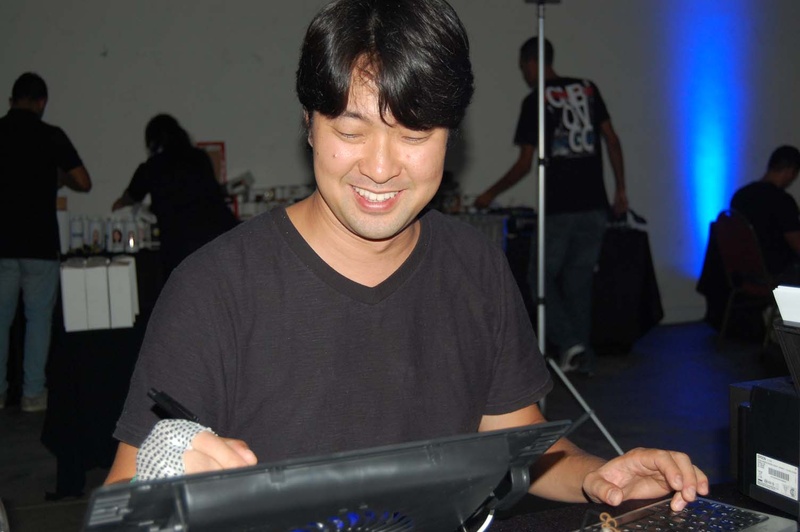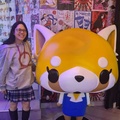Daniel Sato, 35 years old, Sansei, has a very common story among Brazilian Nikkei .
He took a graphic design course for six months “because of dreams that our family put in our heads that working with computing would make us rich”. He also worked as a web designer, which he thought “would be great” for a year, but discovered that that wasn't what he wanted. And he decided to follow another path.
Influence of manga and anime
“I started drawing cars when I was little. My mother said that at the age of three she was already drawing. I think it’s strange (laughs).” But with the caricatures it was different. “I started drawing some manga as a child inspired by Rock Man, a Capcom game, and then something related to games like Street Fighter and KOF (King of Fighters) 97 . Then me and a group of people in the class started drawing all of our classmates, including the teachers, as characters from KOF 97 ”. That's why Daniel thinks he makes a caricature today “without being too hard on the person”.
The caricaturist says that many who started at the same time as him were inspired by manga or American comics – like Marvel. Unlike today, most artists who work with caricature abhor the Japanese style because they consider it too standardized.
Despite this, the manga had a lot of influence on his style. “I started drawing more in the styles of games like KOF 97, Street Fighter Zero 3, anime like Saint Seiya and Yu Yu Hakusho . Today our style [of his team at his company] is not considered by many professionals in the field as caricature, because of the colors today we have a style more cartoon- oriented. But I like anime , even today I watch the continuation of series like Saint Seiya , Inazuma Eleven and so on”, he says.
Work as a caricaturist
The idea for Sato Caricaturas already existed in 2003, but Daniel had little experience and didn't have enough money to buy equipment and, therefore, he left it aside.
The company began its activities in 2011, when he had already returned from Japan, starting from scratch as a caricaturist, “but now with a more entrepreneurial mindset, but with a focus, offering work with quality and responsibility that at the time I believed was not possible. had (and in fact had not).”
Furthermore, Sato thought he needed to “offer the customer something better and at the same time different, something that they would keep and not throw away”, he explains.
Daniel says that at that time there were many caricaturists, but they didn't meet deadlines, weren't committed or didn't even know how to draw. Little by little, he met other professionals and they learned new techniques from each other and even how to behave at events. “Today there are more teams that are well engaged and work responsibly.”
The company's main clients are corporate. This is because companies use caricatures to promote, sell or even motivate employees. One of the main services carried out today is caricatures on mugs for birthdays of the month and conferences. It also caters for private parties and souvenirs.
Interestingly, most or almost all customers are not of Japanese descent, but from the South Korean community. A couple hired Sato to throw their son's first birthday party, which they later discovered was a super important ceremony. The caricaturist says that the fact that he is oriental helped when he was chosen for the job and also because he already knew how to draw a little. Afterwards, he reached out to practically all of this couple's family members and started doing more work for South Koreans.
On his team, only Daniel is a Nikkei . And everyone has their own style of drawing. “In caricature, as there are no rules or standards for how it should or shouldn't be, everyone has a style, which is what's coolest. If they were all the same, you would get bored easily.”

Japanese values and culture
A year after Sato started his profession as a caricaturist, he moved to Japan as a dekassegui . He got married and went there. “I miss there a lot, I think the honesty and sense of justice there are inspiring. I went to work and forgot my house key at the door and no one came in.”
When he learned to speak more Japanese, he was able to better understand the Japanese culture and traditions that are “really different” from Japanese-Brazilian culture. In Daniel's opinion, the values there are “more characteristic” and even today he watches dramas from both Japan and South Korea.
Regarding Japanese culture in Brazil, the caricaturist thinks it is “poorly preserved” and says that the new generations no longer even know how to speak Nihongo compared to other Eastern cultures. “I see children, for example, Korean and Chinese, who maintain the customs as in their country of origin, from language to other aspects.”
Sato explains that these customs have been lost due to the fact that the culture left by Japanese immigrants has been in Brazil for longer than others. “We don’t speak Japanese anymore and I think it’s a shame,” he laments.
© 2017 Tatiana Maebuchi






